Tedious how-This-All-Started story
I did something particularly stupid—I ran the car out of gas on both tanks. I've done it on one before but never on both. At least I thought I had. I was way down on one and nearly out on the other. I kept thnking I'll get gas but then I'd forget and I'd driving somewhere, and think I'll get gas when I'm off the freeway, then I'd forget and I'd be at a shop, or I'm at home, repeat until out of gas.
This time I'd driven it to a shopping center and parked. Came out a short while later and the car wouldn't start. Damn, I'm out of gas on both tanks. I hiked to the gas station, bought two 1-gallon gas cans because of course I don't keep any in the car, filled each and lugged them back. Nice hot day. I got my exercise.
I debated but decided to put one gallon in each tank. Car wouldn't start. Kept sounding like it would almost catch, but not quite. I figured I probably fouled the fuel filter with crap from the bottom of the the tanks. I have a new one but it's at home.
Diagnosis
The tow-truck guy thought I should have put two or even three gallons in one of the tanks. So when I got home I filled up my cans and added two more gallons to each tank. Still won't start.
I put the new fuel filter in. Still won't start. Sounds like it's just ready to catch, but dies.
I ended up pulling the fuel pump. It was gunked on the intake side but easily cleaned. I have a portable 12V power supply so I tested it and it ran okay. Still, I had another on the shelf and swapped it out.
Still won't start. It wants to run, but dies.
On the other end of the car, under the hood, I checked for spark: got it. Pulled the fuel hose at the rail and got raw gas all over the place, so pressure is there. But just in case, I pressure tested. Okay.
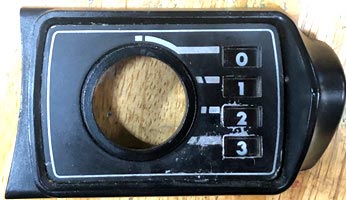
What happened was I wasn't getting any voltage with the car key in Position 2, which is the run or on position. On most modern cars, you put your key in and it's in the off position (0 on the Jaguar). Rotate it clockwise once and it's in accessory (1 here) so you can play the radio. Rotate it again and it's in on or run (2) which is where it is when the engine is running. Twist to the next position (3) and it cranks until you hear it start, and then you let go and it falls back to run (position 2).
I wasn't getting any voltage under the hood (bonnet) with the key in Position 2. I should get 12V on the positive terminal of the coil—nope. I should get 12V on either pin of any fuel-injector plug—nada.
I checked the fuel pump relay, the main relay, the diode pack. They were all good. I pulled the ballast resistor pack and checked it. That was good. They would all work great if electricity got to them.
Got a lot of advice over on Jaguar Forums about things to try and test. I couldn't have done all this without them.
The problem was the ignition switch itself: Position 2 was dead. When I said the car sounded like it was just ready to catch, it was ready to catch. But I'd let the key go and it would drop back to Pos. 2 and the power would be cut, so the engine died. This whole thing about being out of gas was a coincidence. The car would have died in the parking lot even if both tanks had been full.
The Ignition Lock
Jeff Jones Customs has a video on Youtube that shows the ignition lock removal and some notes on how to do it. I was fortunate: I had driven out to a pull-your-own-parts junk yard and someone had done the work for me. I don't know what they wanted but everything I needed turned out to be on the floor already, so I scooped up everything I thought I needed and cashed out.
For our purposes here, the ignition lock is sections: the metal mechanical section and the eletronic switch section. The mechanical part has the key lockset. If you put the proper key in, it allows you to rotate the electric switch in the back. The whole thingt is Jaguar Part DAC 1605; the electric switch is DAC 1607.
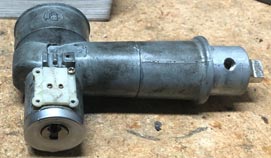
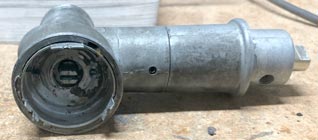
It's the electric switch that's faulty—the part made by Lucas Electric (the company that gave the world the three-position headlamp switch: dim, flicker and off). What happens is that there are two parts of the electric switch, a rotor and a stator. The rotor rotates and the stator stays put.
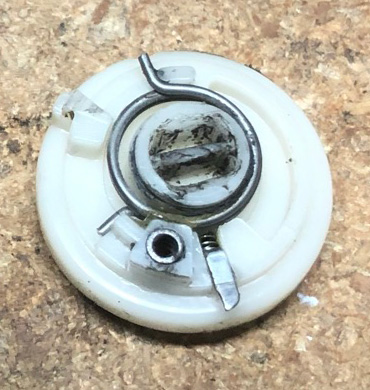
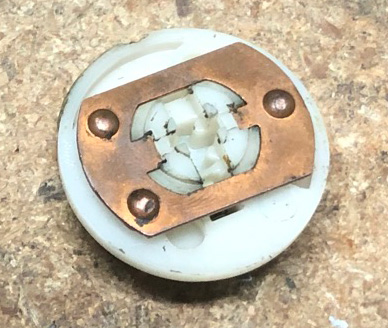
This is what I'm calling the rotor. It goes inside the cup in the back of the mechanical ignition lock. You can see where it's supposed to register and fit. The flip side has the copper plate with the three raised contacts. This rotates so that the three contacts touch three different parts on the stator.
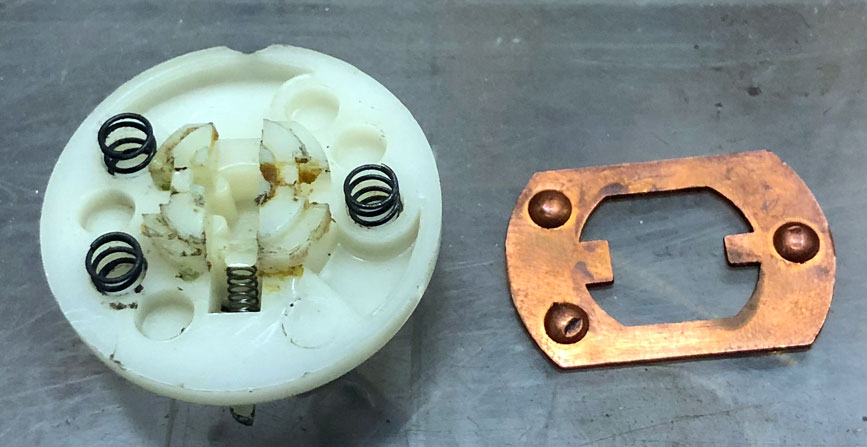
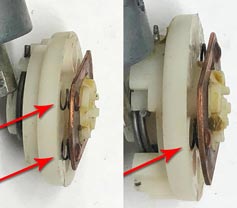
The rotor has three tiny springs that go underneath the contact plate, one under each of the raised contacts. Note that in the photo where the plate is off, I only have two springs showing. I took that photo when I didn't realize it needed three. Every time the plate comes off, those springs fly and they're very easy to lose. I lost all three and didn't realize it. I put the plate on, reassembled everything, when I'd try to crank: nothing happened. Dead as if the battery were disconnected. The springs push the plate against the stator and make a positive contact. Once I had the springs back on, the switching worked properly.
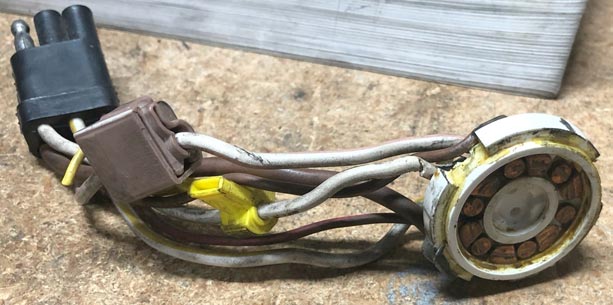
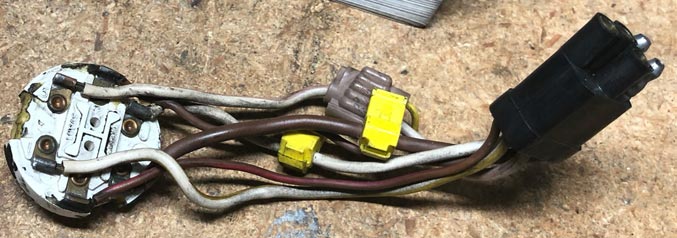
This is what I'm calling the stator. If you look at the "front" of it, you'll see a number of copper contacts. These needed to be scrubbed clean. I used a can of electronics contact cleaner and a fiberglass contact-cleaning brush, and that worked nicely.
I believe that if you buy the electronic switch DAC 1607 as NOS, the rotor and stator are together. But on my junkyard sets (I ended up with two), the stator always pulls out separately and you have to reach in with something to pop the rotor out. Be careful that if you accidentally pull the plate off and leave the rotor in, the springs are going to fly free.
Getting the rotor back into the metal housing is relatively easy. Getting the rotor back on is surprisingly difficult. It goes on relatively easy on the workbench, but far harder when it's in the car.
Final Problem
Now when I switched to Position 2, I got lights on the dash, and I got voltages under the hood where I expected to see them. So, let's try it—nothing. But this time, it didn't even crank. Like trying to start the car with the transmission in gear, except this time I was in park. Tried again in Neutral. Tried again in gear. Tried in Park. Nothing.
Now what? Check for spark—none. None? How did I kill spark? That was working earlier. I started working backward, and I had just gotten to the coil and noticed a wire that was supposed to be on the negative post was disconnected. Oh, yeah—I had taken it off to do a continutity test to see if it connected to Pin 1 on the ECU on the trunk, back when I was still trying to figure out why position 2 was dead. I did get continuity, and I put the ECU back together and installed, but forgot to connect the other end to the coil.
Connected. Try it again—and it cranked.
And it started.
Thank you, lawd. It's hot and the sun is ferocious this summer, and fussing with the car in the driveway was not fun. I was able to drive it into the garage where I can now button everything back up in the shade and with some privacy.
Addendum
It turned out that there was a last piece of the puzzle: the electrical portion of this thing was too loose. It would snap into place but wouldn't make good electrical contact; I had to reach down with one hand and hold it tight while I ran the gear shift and steering wheel with the other. That was not fun.
It turned out that there's a plastic collar that holds the electrical part in place. On the diagram above, it's part number C38037: ignition swtich grommet. The original I had turned brittle and disintegrated. I was lucky in that when I pulled the igition lock stuff out of a wrecking yard car, I got the grommet too. The grommet is a heavy plastic band that's got some flex to it, and I was able to get it over the electrical contact end of the plug. Why not slip it on from the other side, you ask? Because there's another wire, separate from the main harness, that goes back to power the radio; so unless you're willing to cut that wire and reconnect it (I nearly did), then you have to get the grommet over the business end.
Regardless, once you do that, you fit the plastic igition part into the back of the mechanical ignition socket, and once you have a proper fit, you push the grommet on and it will hold DAC 1607 securely in place. At least it did on mine. I was able to start the car and drive it out to the gas station, where I made sure both tanks were full, and got it home again.
And now a second post script because this adventure never seems to end: the plastic grommet broke afterall and the electrical piece fell off. It was just a clean break, so I put a hose clamp around it, put everything back into place and tightened the clamp down securely. I should have done that the first time.
